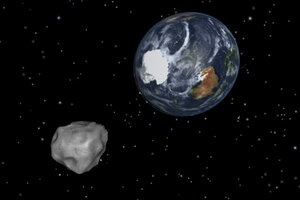Will the United Nations protect us from an asteroid?
The UN voted last week to form an 'International Asteroid Warning Group' charged with coordinating a global response to a hypothetical asteroid on course to Earth.

At the moment, Earth has no coordinated, international plan for how to respond to an impending asteroid strike.
NASA/JPL-Caltech/AP
Earth is not alone. It has lots, and lots, of asteroids for companionship – companions that, should they get too close, could destroy Earth, or at least Earth as we know it.
So, what’s to be done?
Well, never fear, the United Nations is on it. It has established a committee.
The UN voted last week to adopt a proposal from the Association of Space Explorers (ASE) to form an “International Asteroid Warning Group” to defend the planet from asteroids, Scientific American first reported. Member states will use the group to share information on Near Earth Objects (NEOs) and pull together a response to a hypothetical asteroid strike.
The news comes about a week after NASA reported that asteroid 2013 TV135 had skimmed within 4.2 million miles of Earth back in September and is due to return to Earth’s neighborhood in 2032. Should it hit Earth, the explosion would be equivalent to a 2,500 megaton bomb, NASA said – that’s about 125,000 times the size of the bomb dropped on Nagasaki, the Christian Science Monitor reported.
Though NASA has said that odds that the asteroid will impact Earth are just one in 63,000, there’s no getting around the fact that, at the moment, Earth has no control over those odds, the ASE notes. For all the alarm about the rocks hurtling through the solar system, Earth does not have an international defense plan against these threats of impending doom.
Sure, individual states have been gearing up to tackle asteroids on their own. Since April, NASA has been pursuing its so-called Asteroid Redirect Mission, a proposal that includes snagging an asteroid and then sending a manned spacecraft to sample it, all between the years 2018 and 2021. A month later, the European Space Agency (ESA) opened its own office charged with detecting dangerous NEOs.
But, at the moment, there is no international plan for who would respond an asteroid or for when and how the Earth would do so. So, in order to avoid a political tussle over obligations and responsibilities as an asteroid hurtles toward humanity’s home, the ASE is asking the UN to sort it out sooner rather than later.
“Now that humankind has the scientific, technical and operational capabilities both to predict whether an asteroid will come too close for comfort, and to launch operational missions to deflect a potential impact, it is time for the international community to identify the decision-making institutions and begin the development of a coordinated decision-making process,” writes the ASE, in their report.
“In the absence of an agreed-upon decision-making process, we may lose the opportunity to act against a NEO in time, leaving evacuation and disaster management as our only response to a pending impact,” the authors write.
The adopted proposal suggests a two-pronged approach to defending the Earth from asteroids. First, the UN must coordinate efforts to better catalogue just what threats are out there, said Ed Lu, a former NASA astronaut and co-founder of the B612 Foundation, at a talk given this week at the American Museum of Natural History, in New York City.
As of Oct. 14, NASA has recorded the existence of 10,332 Near-Earth objects. But the number of asteroids near Earth is estimated to be a hundred times that, said Mr. Lu. When a meteor exploded above Siberia earlier this year, NASA’s telescopes had not even seen it coming. The explosion injured 1,500 people.
“You cannot deflect an asteroid that we haven’t yet found,” said Lu.
Unless an errant asteroid is detected at least a year out from the date of its expected impact from Earth, there is little that Earthlings can do about it expect fix themselves “a nice cocktail and go out and watch,” said Rusty Schweickart, a former astronaut and a member of the ASE, at the same talk.
The report’s authors also envision the new committee as a forum through which countries can organize a test mission to fend off a problematic asteroid.
“Faced with such a threat, we are far from helpless,” write the authors, in the report.
“For the first time in our planet's 4.5-billion-year history, the technical capacities exist to prevent such cosmic collisions with Earth. The keys to a successful outcome in all cases are preparation, planning, and timely decision-making,” the authors say.

